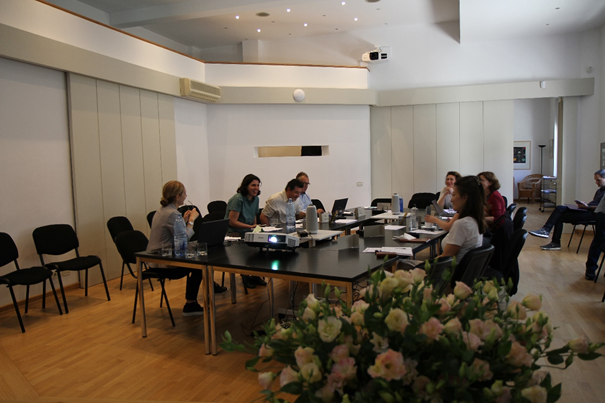About two years after the project „Contested Waterway. Governance and Ecology on the Lower Danube, 1800-2018“ was launched, the first on-site event could take place. The venue was the New Europe College in Bucharest, where a workshop titled „Disturbance on the Danube: State, Infrastructure and the Environment“ was held on September 29-30, 2022. Historians and anthropologists from several countries came together and presented their research on the second-largest river in Europe from different perspectives:

In 2020, the European Environmental Agency warned that climate change is expected to increase the frequency of ‘once-in-a-century’ river floods in most regions of Europe, which it called one of the most damaging extreme climate events. Adaptation to flooding – adjusting to both seasonal overflows and more devastating deluges – has always been a constant feature of communities living near rivers. Being the most international river on the continent, the Danube is a particularly pertinent case study to analyze perceptions of and responses to flooding, and provides a variety of contexts showing how humans have coped with natural disasters. This conference explores how flood prevention and infrastructure development have been intertwined on the Middle and Lower Danube. Combining anthropological and historical methodology, it applies a longue durée perspective to assess the scale of political, social, economic, and ecological transformations triggered by the technological remaking of the river.

In order to disentangle the nexus consisting of floods, states, and infrastructure, we employ the concept of ‘disturbance’. ‘Disturbance’ is used in river management literature to gauge human-induced perturbations to an ecosystem. Such disturbances may be short-term, acute episodes such as a spillover of chemicals, or long-term disturbances when humans make physical changes to a river, for instance by changing its course. Disturbances lead to a loss of biodiversity and species, and impoverish the previously rich environment. However, from the perspective of riparian communities and states (especially modern states), flooding also constitutes a disturbance. Catastrophic floods have resulted in the loss of human life and serious economic damage. Thus, since their inception, states have tried to control rivers by building dams and levees, and to harness their force. We suggest here that there are two different perspectives on a river’s disturbances. One concerns disturbances caused to rivers by humans and states. This is the perspective of the river distressed during human history, mainly by large infrastructure. The second perspective is that of humans and states. For both actors, a flooding river – especially catastrophic flooding – is a major disturbance to the local and national economy and the riparian population.

Program
Thursday, 29 September 2022
13.00–14.00 – Lunch at NEC
14.00–14.15
Introductory remarks from the project leader and the local organizers
14.15–16.15
Panel 1
Nature and Technology along the Lower Danube (I)
Chair: Ștefan DORONDEL
Onur INAL and Deniz ARMAĞAN AKTO, University of Vienna and Bilkent University, Ankara
Coping with the River: Nature, Empire, and the Making of the Early Modern Ottoman Danube
Luminița GĂTEJEL, IOS Regensburg
A Young State Empowered by Technology? Floods and Negotiating the Politics of Responsibility in Wallachia during the 1840s
Constantin ARDELEANU, NEC and ISSEE Bucharest
Free from Hindrances: Shipping and Fishing Mobility Systems in the Danube Delta Region (1856–1914)
16.15–16.30 – Coffee break
16.30–17.30 – Keynote lecture
Gertrud HAIDVOGL, Institute of Hydrobiology and Aquatic Ecosystem Management Vienna
How to Build a Waterway. Pre-industrial and Industrial Practices on Europe’s Great Navigable Rivers
Friday, 30 September 2022
10.00–11.20
Panel 2
The Danube and Its Islands
Chair: Gertrud HAIDVOGL
Merve NEZIROGLU, GWZO Leipzig
Contested Islands along the Lower Danube: Ada Kaleh and Serpent Island
Milica PROKIC, University of Glasgow
The Spectre of Infrastructure Over Belgrade’s Urban Oasis: The Layered Past and The Uncertain Future of the Great War Island
11.20–11.40 – Coffee break
11.40–13.00
Panel 3
Nature and Technology along the Lower Danube (II)
Chair: Luminița GĂTEJEL
Ivelina EFTIMOVA, ‘Konstantin Preslavsky’ University of Shumen
The Kalimok – Brushlen Protected Area and Ecotourism – (Un)Problematic Coexistence
Constantin IORDACHI, CEU PU Vienna
Communist Infrastructure in Post-Communism
13.00–15.00 – Lunch
15.00–17.00
Panel 4
River Disasters
Chair: Constantin ARDELEANU
Maja PETROVIC ŠTEGER, ZRC SAZU Ljubljana
Waste, Value and Death in a Riparian Environment
Ștefan DORONDEL, ‘Francisc I. Rainer’ Institute of Anthropology Bucharest
The History and Ethnography of a Disaster
Stelu ȘERBAN, ISSEE Bucharest
Floods and Prosaic State on the Bulgarian Lower Danube
17.00–17.15 – Conclusions
This workshop was organized within the project “Contested Waterway. Governance and Ecology on the Lower Danube, 1800–2018”, supported by the Leibniz Association (2020–2023).